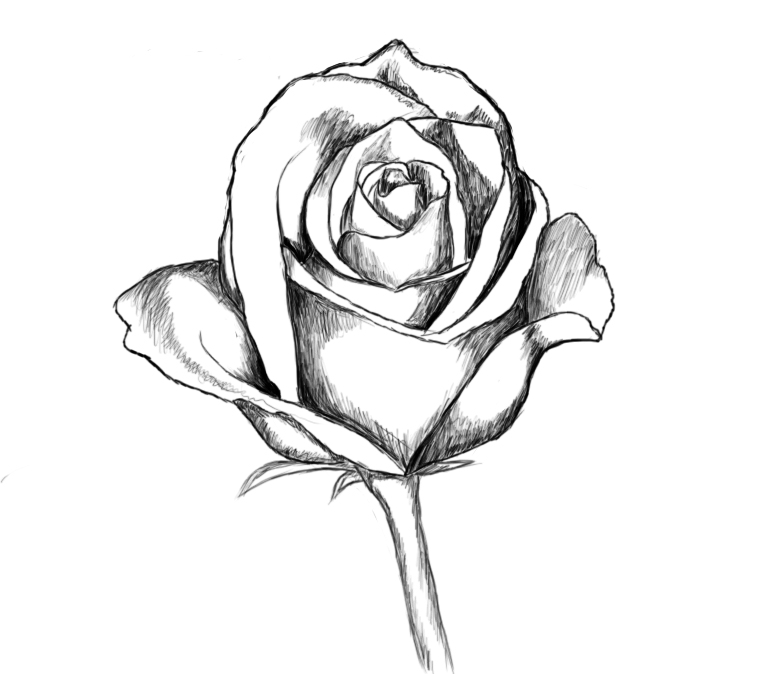Mastering The Art Of Rose Drawing: A Comprehensive Guide
Rose drawing is an enchanting skill that allows artists to express their creativity and appreciation for nature's beauty. In this article, we will explore the various techniques and tips for mastering the art of drawing roses, from understanding their anatomy to applying effective shading techniques. Whether you're a beginner or an experienced artist looking to refine your skills, this guide is designed to provide valuable insights to help you create stunning rose illustrations.
As we navigate through this guide, you will learn about the tools and materials needed for rose drawing, various techniques to enhance your artwork, and the importance of practice and patience. By the end of this article, you'll be equipped with the knowledge and confidence to create beautiful rose drawings that can be cherished for years to come.
Table of Contents
- Understanding the Anatomy of Roses
- Essential Tools and Materials for Rose Drawing
- Step-by-Step Guide to Drawing Roses
- Techniques to Enhance Your Rose Drawing
- Shading and Coloring Your Rose Drawings
- Common Mistakes to Avoid When Drawing Roses
- Inspiration and Resources for Rose Drawing
- Conclusion and Next Steps
Understanding the Anatomy of Roses
Before diving into the drawing process, it's essential to understand the anatomy of roses. This knowledge will help you capture the unique features of this flower accurately. Here are the key components to observe:
- Petals: The colorful parts that attract pollinators.
- Stamens: The male reproductive parts that produce pollen.
- Pistils: The female reproductive parts that contain the ovary.
- Sepals: The protective leaf-like structures beneath the petals.
- Thorns: The sharp projections on the stem that deter herbivores.
By studying these components, you can create a more realistic representation of a rose in your drawing.
Essential Tools and Materials for Rose Drawing
To start your rose drawing journey, it's important to have the right tools and materials. Here’s a list of essentials:
- Pencils (HB, 2B, 4B, and 6B)
- Sketch paper or drawing pad
- Eraser (kneaded and regular)
- Blending stump or tortillon
- Colored pencils or watercolor pencils (if coloring is desired)
Having quality materials can significantly impact the outcome of your artwork, so invest in good tools to enhance your drawing experience.
Step-by-Step Guide to Drawing Roses
Now that you have the necessary tools, let’s dive into the step-by-step process of drawing a rose:
Step 1: Sketch the Basic Shapes
Start with light pencil strokes to create the basic shapes of the rose. Draw a circle for the bloom and a small oval for the bud. This will serve as the foundation for your drawing.
Step 2: Outline the Petals
Build upon the basic shapes by adding the outline of the petals. Pay attention to the natural curves and overlaps of the petals. Don’t worry about perfection at this stage; focus on capturing the essence of the flower.
Step 3: Add Details and Texture
Add more details to the petals by incorporating lines to indicate texture and depth. Observe real roses for reference to understand how light interacts with the petals.
Step 4: Draw the Stem and Leaves
Once the bloom is complete, add the stem and leaves. Use simple lines for the stem and create leaf shapes that complement the flower. Remember to include the thorns for realism.
Step 5: Refine Your Drawing
Go over your lines to refine the drawing. Erase any unnecessary marks and make adjustments where needed. This is the time to ensure proportionality and accuracy.
Step 6: Shading and Final Touches
Begin shading your rose to add depth. Use a blending stump to create smooth transitions between light and dark areas. Add highlights to the petals to mimic natural light.
Techniques to Enhance Your Rose Drawing
Here are some techniques to take your rose drawing to the next level:
- Layering: Build up layers of shading gradually for a more realistic effect.
- Cross-hatching: Use this technique to create texture and depth.
- Watercolor Techniques: If using watercolor pencils, experiment with wetting your brush to blend colors.
Shading and Coloring Your Rose Drawings
Shading and coloring can elevate your rose drawing. Follow these tips:
- Use a range of pencils to achieve different shades.
- For colored pencils, blend colors to create depth and richness.
- Consider the light source when shading to create realistic highlights and shadows.
Common Mistakes to Avoid When Drawing Roses
Even experienced artists can make mistakes. Here are some common pitfalls to be aware of:
- Overcomplicating the shapes of petals.
- Neglecting the importance of proportion.
- Not observing real-life roses for reference.
Inspiration and Resources for Rose Drawing
Looking for inspiration? Consider the following resources:
- Art books about flowers
- YouTube tutorials on rose drawing
- Online art communities for feedback and support
Conclusion and Next Steps
In conclusion, mastering the art of rose drawing involves understanding the anatomy of the flower, utilizing the right tools, and practicing various techniques. With dedication and patience, you can create stunning rose illustrations that capture the beauty of this timeless flower. We encourage you to leave a comment below, share your rose drawings, or explore more articles on our site to further enhance your artistic journey.
Thank you for reading! We hope this guide has inspired you to pick up your pencils and start drawing. Remember, the more you practice, the better you'll become. Happy drawing!
Eve Best: A Comprehensive Look At The Acclaimed Actress
The Sparkling World Of Swarovski: A Comprehensive Guide
Rick Astley: The Icon Behind The Hit "Never Gonna Give You Up"

